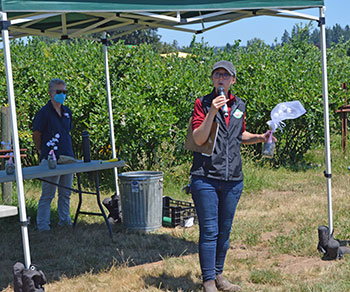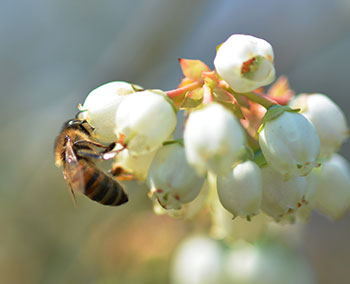Hive Management in Blueberries Topic of Multistate Project
At the 2022 Oregon Blueberry Field Day, Washington State University associate professor in small fruits Lisa DeVetter updated participants on a multistate project measuring the effects of hive-stocking density, colony placement and other hive management practices that can influence honeybee pollination.
 |
WSU Associate Professor Lisa DeVetter updates Oregon Blueberry Field Day participants on a multi-state research project on hive management in blueberries. |
To begin with, DeVetter said that researchers from WSU, Oregon State University and Michigan State University found that there were more honeybee visitations to blueberries when hives were clumped together versus when hives were dispersed. But researchers found no difference in fruit set, berry size and seed set between the two treatments.
“Even though we saw greater honeybee visitation, it wasn’t to the point where it manifested itself into a difference in seed set, berry size and yield,” DeVetter said.
In both the clumped and dispersed treatments, researchers found no pollination deficit across all study locations, she added, indicating that pollination was optimal and likely why no treatment effects on yield components were observed.
“We will see what we find out this year, because, like in Oregon, Washington state had poor pollination conditions,” she said at the July 20 field day in Aurora.
As for stocking density, researchers have previously found that yields improve when doubling stocking densities from four to eight honeybee hives per acre in the Duke variety.
“But when we repeated that in Draper and Liberty, we don’t see the same effect,” DeVetter said.
This past year, researchers at Michigan State University and the University of Florida repeated a similar trial in Bluecrop, Emerald and Jewel and found no differences in honeybee visitation regardless of stocking density.
“So that was interesting,” DeVetter said. “And then when we looked at stocking density effects on fruit set and berry weight and seed set, we also didn’t see any differences across the states and cultivars, indicating stocking density had no effect.” The research is being repeated this year in Michigan and Florida.
In a separate trial, DeVetter and postdoctoral researcher Maxime Eeraerts at WSU found that stocking density in the broader landscape did have an effect on yield.
“As you might surmise, the more blueberries around your field, the more hives you are going to have around your field,” she said. “What was interesting to us is how significant the relationship is when you look at honeybee visitation and then the landscape level of honeybee hives within a 1,000-meter radius.
 |
“What this means is that we really need to consider the landscape around an individual field when we are trying to come up with a stocking density recommendation,” she said. “If your neighbors are stocking really high or low, and they also grow blueberries, you might want to adjust your stocking density correspondingly.
“And talk with your beekeeper. If they are stocking fields adjacent to yours, try to find out the stocking rate so you can then increase or decrease the stocking rate in your field,” she said.
In a related study, Eeeraerts and DeVetter found that semi-natural habitat around a field did not decrease honeybee visitation, but did increase wild bee populations visiting blueberry flowers.
“And, interestingly, if there was more blueberry acreage around a field, we saw a significant decline in wild pollinators,” she said. “So, if you are interested in wild pollinators, trying to have some natural habitat elements and not blueberry crops can increase those populations.”
In yet another trial, DeVetter said the multistate team she is working with is looking at how hive placement affects pesticide exposure. “One would hypothesize that the closer the hives are to the field, the greater the likelihood they might be exposed to pesticides that are being applied during the bloom period, like pre-bloom fungicides for botrytis and mummy berry.”
She did not have data yet for that work, but plans to share results when available.
DeVetter said that trial, as well as the stocking density and stocking rate trials, were being repeated in 2022.
DeVetter noted that this research has been made possible through grants provided by the USDA Specialty Crop Research Initiative, as well as the Washington and Oregon Blueberry Commissions.
The 2022 Oregon Blueberry Field Day, held at the North Willamette Research and Extension Center, drew about 100 participants.